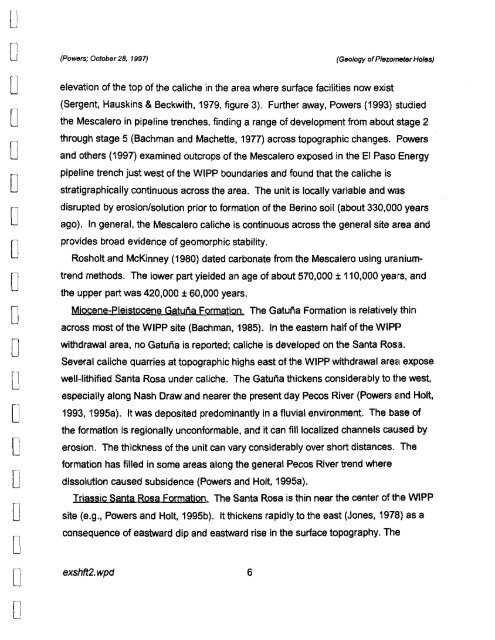o - Waste Isolation Pilot Plant
o - Waste Isolation Pilot Plant
o - Waste Isolation Pilot Plant
You also want an ePaper? Increase the reach of your titles
YUMPU automatically turns print PDFs into web optimized ePapers that Google loves.
u<br />
o<br />
o<br />
o<br />
D<br />
o<br />
o<br />
o<br />
o<br />
o<br />
o<br />
o<br />
o<br />
oo<br />
o<br />
o<br />
o<br />
o<br />
(Powers; October 28. 1997)<br />
(Geology ofPiezometer Holes)<br />
elevation of the top of the caliche in the area where surface facilities now exist<br />
(Sergent, Hauskins & Beckwith, 1979, figure 3). Further away, Powers (1993) studied<br />
the Mescalero in pipeline trenches, finding a range of development from about stage 2<br />
through stage 5 (Bachman and Machette, 1977) across topographic changes. Powers<br />
and others (1997) examined outcrops of the Mescalero exposed in the EI Paso Energy<br />
pipeline trench just west of the WIPP boundaries and found that the caliche is<br />
stratigraphically continuous across the area. The unit is locally variable and was<br />
disrupted by erosion/solution prior to formation of the Berino soil (about 330,000 years<br />
ago). In general, the Mescalero caliche is continuous across the general site area and<br />
provides broad evidence of geomorphic stability.<br />
Rosholt and McKinney (1980) dated carbonate from the Mescalero using urBlniumtrend<br />
methods. The lower part yielded an age of about 570,000 ± 110,000 yeal's, and<br />
the upper part was 420,000 ± 60,000 years.<br />
Miocene-Pleistocene Gatulia Formation. The Gatulia Formation is relatively thin<br />
across most of the WIPP site (Bachman, 1985). In the eastern half ofthe WIPP<br />
withdrawal area, no Gatulia is reported; caliche is developed on the Santa Rosa.<br />
Several caliche quarries at topographic highs east of the WIPP withdrawal are~1 expose<br />
well-Iithified Santa Rosa under caliche. The Gatulia thickens considerably to the west,<br />
especially along Nash Draw and nearer the present day Pecos River (Powers Bind Holt,<br />
1993, 1995a). It was deposited predominantly in a fluvial environment. The base of<br />
the formation is regionally unconformable, and it can fill localized channels caused by<br />
erosion. The thickness of the unit can vary considerably over short distances. The<br />
formation has filled in some areas along the general Pecos River trend where<br />
dissolution caused subsidence (Powers and Holt, 1995a).<br />
Triassic Santa Rosa FOrmation The Santa Rosa is thin near the center of the WIPP<br />
site (e.g., Powers and Holt, 1995b). It thickens rapidly.to the east (Jones, 1978) as a<br />
consequence of eastward dip and eastward rise in the surface topography. The<br />
exshft2. wpd 6

















